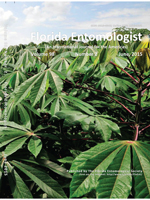The citrus leafminer (CLM) Phyllocnistis citrella Stainton (Lepidoptera: Gracillariidae) was first recorded in Brazil in 1996. In 1998, the parasitoid Ageniaspis citricola Logvinovskaya (Hymenoptera: Encyrtidae) was introduced and established in many regions of the country. In this study, 130 one-hour-samplings of sweet orange leaves (Citrus sinensis [L.] Osbeck) hosting CLM pupal chambers were carried out to estimate the CLM parasitism rate (%) by its parasitoids in 7 regions of São Paulo State between 2000 and 2008. The sample sizes varied from 10 to 275 leaves (mean = 65). The most abundant parasitoid was the encyrtid A. citricola (found in 91.8% of the samplings). The highest level of CLM parasitism by A. citricola was recorded in the southern region (Botucatu), 70.2 ± 6.6 (mean ± SEM), and the lowest level was recorded in the northern region (Barretos), 12.8 ± 5.7%. CLM parasitism by A. citricola and by native parasitoids (Galeopsomyia fausta LaSalle, Cirrospilus spp. and Elasmus sp.) did not differ between seasons. The 6-fold increase in the use of insecticides in citrus groves, after 2004 when the Huanglongbing (HLB) disease was found in São Paulo State, did not reduce the level of CLM parasitism. The level of parasitism was 50.8 ± 4.2% before the advent of HLB (2000–2004) and 56.0 ± 4.4% thereafter (2005–2008), indicating adaptation of A. citricola in a disturbed agroecosystem.
How to translate text using browser tools
1 June 2015
Natural Parasitism of the Citrus Leafminer (Lepidoptera: Gracillariidae) Over Eight Years in Seven Citrus Regions of São Paulo, Brazil
Paulo Eduardo Branco Paiva,
Pedro Takao Yamamoto

Florida Entomologist
Vol. 98 • No. 2
June 2015
Vol. 98 • No. 2
June 2015
Ageniaspis citricola
biological control
controle biológico
HLB management
insecticide
inseticida
manejo de HLB




